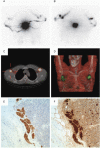Lymphoscintigraphy Using Tilmanocept Detects Multiple Sentinel Lymph Nodes in Melanoma Patients
- PMID: 36705261
- PMCID: PMC9893075
- DOI: 10.1177/10732748231153775
Lymphoscintigraphy Using Tilmanocept Detects Multiple Sentinel Lymph Nodes in Melanoma Patients
Abstract
Background: Technetium-99m-labeled Tilmanocept, a multivalent mannose, is readily internalized by the CD206 surface receptor on macrophages and dendritic cells which are abundantly present in lymph nodes. We want to examine the drainage patterns of Technetium-99m-labeled Tilmanocept to sentinel lymph nodes (SLNs) in melanoma patients following the 10% rule.
Methods: Multi-center retrospective review of patients with cutaneous melanoma undergoing SLN biopsy using Technetium-99m-labeled Tilmanocept between 2008 and 2014 was conducted. Statistical methods were used for data analyses.
Results: Of the 564 patients (mean age of 60.3 and 62% male) with preoperative lymphoscintigraphy showing at least one SLN, several primary tumor sites were included: 27% head/neck, 33% trunk, 21% upper extremity and 19% lower extremity. For the head/neck primary site, 36.5% of patients had multiple draining basins; for the trunk site, 36.4% of patients; for the upper extremity site, 13% of patients; and for the lower extremity, 27.4% of patients. A median of 3 (range 1-18) SLNs were identified and resected. Overall, 78% of patients had >1 SLN identified by Technetium-99m-labeled Tilmanocept. In a multivariate model, patients with >1 SLN were significantly associated with age, Breslow depth, tumor location and higher AJCC tumor stage. A total of 17.7% of patients (100/564) had a positive SLN identified. A total of 145 positive SLNs were identified out of 1,812 SLNs with a positive SLN rate of 8%. Positive SLN status was significantly associated with younger age, greater Breslow depth, mitosis rate, higher AJCC tumor stage, presence of ulceration and angiolymphatic invasion.
Conclusions: Using the 10% rule, Technetium-99m-labeled Tilmanocept detects multiple SLNs in most melanoma patients.
Keywords: melanoma lymphatic drainage; melanoma sentinel lymph nodes; tilmanocept (lymphoseek).
Conflict of interest statement
The author(s) declared the following potential conflicts of interest with respect to the research, authorship, and/or publication of this article: MKS-Consulting to Merck, Cepheid, Myriad Genetics, Melanoma Diagnostics. SPL-Consulting to Cardinal Health, Castle Biosciences. JSZ-Consulting to Castle Biosciences, Philogen, Merck, Delcath Systems. Grant/Research Support–Castle Biosciences, NeraCare, Philogen, Provectus.
Figures



Similar articles
-
Detection of melanoma, breast cancer and head and neck squamous cell cancer sentinel lymph nodes by Tc-99m Tilmanocept (Lymphoseek®).Clin Exp Metastasis. 2022 Feb;39(1):39-50. doi: 10.1007/s10585-021-10137-4. Epub 2021 Dec 28. Clin Exp Metastasis. 2022. PMID: 34962630 Free PMC article. Review.
-
Combined analysis of phase III trials evaluating [⁹⁹mTc]tilmanocept and vital blue dye for identification of sentinel lymph nodes in clinically node-negative cutaneous melanoma.Ann Surg Oncol. 2013 Feb;20(2):680-8. doi: 10.1245/s10434-012-2612-z. Epub 2012 Oct 3. Ann Surg Oncol. 2013. PMID: 23054107 Free PMC article. Clinical Trial.
-
Within-patient comparison between [68Ga]Ga-tilmanocept PET/CT lymphoscintigraphy and [99mTc]Tc-tilmanocept lymphoscintigraphy for sentinel lymph node detection in oral cancer: a pilot study.Eur J Nucl Med Mol Imaging. 2022 May;49(6):2023-2036. doi: 10.1007/s00259-021-05645-0. Epub 2021 Dec 28. Eur J Nucl Med Mol Imaging. 2022. PMID: 34962582
-
Use of low-dose technetium Tc 99m sulfur colloid to locate sentinel lymph nodes in melanoma of the head and neck: preliminary study.Laryngoscope. 2001 Aug;111(8):1366-72. doi: 10.1097/00005537-200108000-00010. Laryngoscope. 2001. PMID: 11568570
-
Radioguided sentinel lymph node biopsy in patients with malignant cutaneous melanoma: the nuclear medicine contribution.J Surg Oncol. 2004 Mar;85(3):141-51. doi: 10.1002/jso.20027. J Surg Oncol. 2004. PMID: 14991886 Review.
Cited by
-
Preoperative and Intraoperative Identification of Sentinel Lymph Nodes in Melanoma Surgery.Cancers (Basel). 2024 Aug 5;16(15):2767. doi: 10.3390/cancers16152767. Cancers (Basel). 2024. PMID: 39123494 Free PMC article.

